How we crossed the ocean
From The Galapagos Islands of Ecuador to the Islas Marquises of French Polynesia will be the longest single leg of our journey home in ITIKI, at 3020nm (that's 5,600kms)! After a very easy run down from Panama to Galapagos, and after a lot of discussion and reflection on how far we have come, the passages we have done, the conditions we were expecting, we decided not to take on any crew for this passage. It would just be the two of us. We felt confident we could do it, mentally and physically, although in the back of my mind I knew it would be challenging for me if something happened to Keith. We felt we were pretty well prepared though, and although you can’t control everything on balance we were quietly confident.
To put our journey into perspective, this 3,000nm leg to the Marquesas from Galapagos is nearly 5 x the Sydney to Hobart yacht race (which is 628nm). Since we picked up ITIKI in La Rochelle we have done 19,000nm (34,000km) as far as the Galapagos. The furthest point east we made it was in Turkey, which is now 7,150nm away (13,240kms, as the crow flies) from Galapagos. Our home town of Sydney now lies 6,950nm to our west. Once we arrive in the Marquesas we will be only 3,900nm (7,200kms) from home!
How do you prepare for 3 weeks at sea?
We expected the Pacific passage to take just under 3 weeks in total, assuming we would head south to pick up the easterly trade winds and then turn right to have a down-wind run. This leg is known as the Coconut Milk run after all. Preparing for any long passage, the main focus is on safety of course but comfort has to come into it as well. We have a checklist of standard preparations, here are some of the key points:
And we are off!
With the Galapagos exit inspectors gone, we have a final cup of tea and can delay no longer. We lifted anchor about 11:30am, John and Gill from SV Mehalah waved us off. Bearing in mind we are still in the area called the Doldrums, we expected some lightish conditions before getting into the solid and reliable easterly trade winds. We were advised to head south to 4-5 degrees latitude, before turning right to run downwind. We have a good SE breeze initially steady at 12kts so it's perfect for the gennaker. Seas are flatish initially with good current in our favour so we are making great speeds. The wind soon built to the limit of the gennaker so took it down, and didn’t lose much in speed at all with the genoa.
That’s been a long time coming!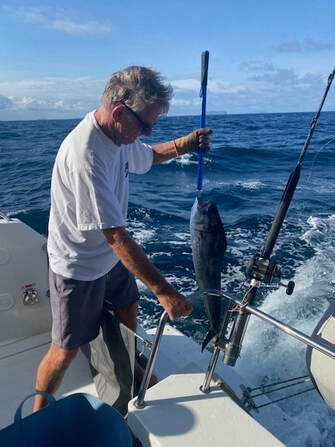 Keith vs Mahe Mahe Keith vs Mahe Mahe
Just before 4pm, just to the south of Isabela, we heard a sound that we haven’t heard before. Yes the zing of the fishing rod! I bring the boat up head to wind to slow her down while Keith tries to reel it in. We were doing 8s and I dropped her down to 4s which seemed to be enough. Keith thinks we have lost it for a while but as it comes closer we see the unmistakable shape of a Mahe Mahe, and a good sized one too. I frantically rifle through the lazarette to find gloves, the gaff, the woefully inadequate net and finally the big blue plastic bucket. The fish is really fighting as he gets the transom, Keith gets the gaff in but it is not a fatal blow. Sadly it is not a quick death and we both really feel for this creature. We tell ourselves we will honour it by savouring its flesh…. As it dies the bright yellow colour slowly fades. I manage to take a few pictures and get a message off to Ollie from Mai Tai, whose rod we are using, and TheWildThings, who gave us our most recent fishing lesson. Keith manages to kill our catch with the filleting knife and eventually hacks off the head and removes the intestines without puncturing them. I find the fishing book and open it to the filleting page and set up the BBQ/filleting tray. Keith does his best to skin our catch - all up landing the fish and getting it filleted took about 1.5 hours. I am sure we will get better with practice! Anyway that’s dinner sorted tonight, and tomorrow night, and 2 more serves in the freezer. I am glad I didn’t rush to the fish markets this morning! It was also lucky we had the genoa up and not the gennaker as we probably would have had to furl the latter and probably would have lost the fish and all the line!
Strange Currents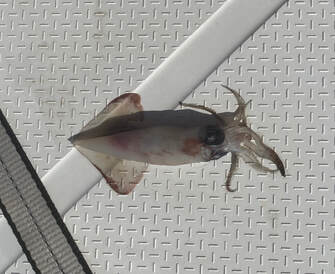 One of many flying squid that we caught One of many flying squid that we caught
On my watch around 3am we go through a very strange patch of water. It was dark but it suddenly sounded like we were sailing through rapids. I put the torch out and saw flatish whitecaps even though we only had 8kts TWS. Wind over tide it seems as the current was 2kts on from our starboard side, on the beam, whilst the wind is directly opposite on our port beam! The torchlight picks up hundreds of tiny fish (or maybe even squid) jumping and occasionally something larger chasing them! I also see some floating plastic bottles. This lasts about 20mins and we are back to normal seas again. Very strange.
Later that afternoon I see some whale blows about a mile away, then some dorsal fins and later 2 small whales breaching. Its lovely to see them but the recent experience of SV Raindancer I mentioned earlier puts a dampener on the experience. Sunset is spectacular with the clouds on the horizon looking almost like trees. There is a sliver of a moon just above the coral coloured horizon which sinks not long after the sun. The sky is fairly clear most of the night and stars are magnificent. Rinse and repeat
As the journey rolls on, the days start to blur and become repetitious. It is a little boring, which actually is a good problem to have! With just two of us, we keep a pretty standard 4 hour watch system. It goes like this:
We keep the same times and fall into a routine. During the day when there is good visibility we rely on the autopilot and use the time to do odd jobs, prepare meals, catch a few zzzzs etc Once the sun goes down we are stricter about keeping a look out. Fishing boats become rarer, but they are often not on AIS and so we keep a lookout for lights on the horizon. When off watch, catching up on rest and sleep is really important. On shorter, overnight passages through busy traffic areas the “off watch” person sleeps in the saloon on the sofa to be close at hand, but on this longer passage where there are few other boats around, its nice to sleep in our own bed, even though we are not in it at the same time. The only problem is that the autopilot is on the starboard side and the intermittent and irregular groaning coming from the hydraulic arm of the autopilot is enough to drive one crazy, as it is right next to your head. So we make up the bed in the port aft cabin and that is where we end up sleeping when off watch. Lovely and quiet!
WE FIND THE TRADE WINDS - Parasailor up!
The are 10 degrees to the north and south of the Equator is known as the Doldrums. In this region, the winds can be fickle and at times non existent. We have been fortunate that we have had enough wind to sail all the way from the Galapagos.
On the afternoon of day 4 we hit the jackpot – we find the trade winds at around 4degrees south. The wind angle is now perfect for us to turn right so we changed to the Parasailor. This involves furling and stowing the gennaker, putting engines on so we can come up head to wind, dropping the main then turning downwind again onto course, hoisting and launching the Parasailor. We love our Parasailor, its easy to manage and in calm conditions it can keep us moving along nicely. We hoisted it in light winds, which were directly from behind. Progress was slow at first, it’s not our fastest angle of sail, but the creak and flog of the mainsail was gone and the sail just looks after itself. It rotates from side to side as the wind direction shifts through a few degrees, or the angle of the boat changes as we are picked up or nudged along by waves. It makes for very pleasant sailing conditions. We are sailing on apparent wind hold which keeps us trimmed to take advantage of any wind shifts. We are making great progress west and slowly creeping southwards as well as westward.
After dropping the main we noticed that the outer sheath of the 1st reefline had chafed through – again! This line has been chafed through, chopped off and re-led several times now, each time we think we have figured out and bypassed the problem but it seems not. This time Keith puts a Technora sheath over where we think the chafe point is. Let’s hope we have nailed it now.
Loved to death!
Fast forward to day 17 and we started getting some blustery conditions with the wind becoming increasingly shifty. We had to intervene a bit too often, changing course to ensure that the kite stayed full and trimmed. Sudden wind shift collapses the kite before the autopilot, or the person on watch, can react. This happened a few too many times and we should have seen the writing on the wall, but sadly after one big collapse, the force of refilling the kite ripped the top of the sail horizontally, just above the wing. I was on watch but Keith heard the bang of the wind refilling the sail and was quickly up from the bed to investigate. He was standing in the saloon when I told him we had ripped the kite but he was looking very confused like he didn’t believe me. From where he was standing he could see the bottom half of the kite still flying perfectly trimmed! Meanwhile the sky was visible through the top half!
Regular readers will recall that we shredded the lower half of the kite on our Atlantic crossing. This lower half was ripped up so badly it had to be completely replaced with new cloth. Thankfully this part is still intact, as is the wing. The upper section was the original cloth and had clearly seen more sunshine, moonlight and good times! We were able to snuff the kite and change to the main and Genoa (both with 1 reef) in time for sunset. Squally conditions continued throughout the night with dark, dense clouds passing over is, bringing more wind and some rain. We passed a freighter going the other direction whilst in the midst of a particularly nasty patch so had to hold a tight course. Shifty and gusty winds made for a busy and bouncy night. Our milk run has turned into a milk shake as seas are quite big too but all is well on board. At least we are making good speed!
Parasailor in the sail loftOut of sight, out of mind
It was about 25 miles from Isabela, Galapagos, when we lost sight of land. We essentially went 18 days and nights without seeing land. The further we went into the Pacific, the further we got from land and civilisation. Once we reached the middle of the Pacific, we were 1,500nm or 2,780 km) from land, which is way further than the International Space Station at 408km from Earth! Have you ever wondered what that feels like? Me too. Amazing, daunting, somewhat unnerving, but we don’t really spend too much time dwelling on it. I think that if you did you could very easily become unhinged. At sea level it is 3 miles to the horizon, so looking all around us we see a 6 mile diameter circle of sea, our planet, our world. Our universe crunches down to our 13.3m x 7.6m space called ITIKI. A bit like the 2 weeks of quarantine in the early days of CoVID, except no Netflix and no sending out for Uber eats. Alot of yachts have got StarLink now but it’s actually quite nice not having internet, a good reminder of how much time you can waste going down rabbit holes.
Instead we are living in the moment, focusing on keeping the boat moving and systems running smoothly. We get occasional messages via the Sat phone from other boats nearby, and the novelty reminds me of the early days of dial up internet! A well oiled Machine
We are carefully monitoring the battery levels and managing our power. We need to keep our fridges and freezers running but also keep the autopilot working, so we don’t have to hand steer! If we don’t get enough power from the sun because of cloudy days or shading from the sails, we need to run the generator. We make water every few days to keep the tanks nice and full, and keep up with the washing. There are always odd jobs to do, and we regularly check the boat for wear and tear, chafe or compression on lines and we rock the Parasailor Halyard every second day.
I make bread every second day, yoghurt twice a week, and am often planning and cooking meals etc. We make sure we look after ourselves, it’s important to eat well and drink plenty of water. We listen to podcasts, our late afternoon ritual which has replaced “sundowners” - working our way through the gripping BBC podcasts “13 Minutes to the Moon” and “The Lazarus Heist”. We read, do Sudokus, sort out photos and try to catch up on blogs. What time is it?
We end up crossing several time zones on our way across the Pacific. Friday night is usually marked by a Cosmopolitan so in keeping with tradition we enjoyed the “on passage” version of this classic cocktail, listened to a podcast and watched the sunset. It’s easy to lose track of time when the Parasailor and autopilot are doing all the work! I was officially on watch but it was lovely to share time together at the helm rather than being ships that pass in the night!
Keith did the 8pm til midnight watch while I slept. When I woke and checked the time on my iPad I saw I had overslept by 40mins! Why had he not woken me?! That’s the rules! When I got up there was much confusion as the chart plotter was showing 1 hour earlier than our phones. Keith was insistent he had not extended his watch, and indeed had only ticked off 3.5 hours. Hmmm… It seems that the chartplotter had changed time to 1 hour earlier but when? It took us a while to realize that it had done this during cocktail hour without us noticing! All very confusing but at least we had shared “the long watch”! Over the rest of our journey the chart plotter changed time zones several times, until we finally got into Marquesas time, there were a few longer watches which was a bonus for whomever was off watch! Weather conditions
Well over a period of 18 days of our passage we obviously had a lot of different conditions, but overall it was a relatively easy passage. We managed to sail pretty much all the way from leaving Galapagos at one end, to seeing land at the other end. We never lost the wind completely as some yachts did. We always had more than enough breeze to keep moving. The only time we motored was to take down the mainsail and change to the Parasailor, and on sighting land 33nm out. Sometimes keeping us moving entailed a fair bit of work and concentration, playing with the wind angle to get the most out of our sails, other times we just sat back and let the autopilot do all of the work! Sometimes we were grateful to just be moving at 2-3kts. For the first half of the trip we had a good 1-2kts of current with us which was a real bonus. At the other end of the scale, we rarely had gusts over 25, and if we did it was short lived. We had the odd squall but interestingly, whilst we regularly saw thick, low, dark cloud they often did not show anything on the radar, rarely lifted the wind considerably and brought little to no rain and – thankfully – no lightening. We know of one yacht that copped a direct hit from lightening mid-Pacific which took out 90% of their electronics including main and back up autopilot. What a nightmare!
There were times when the sea state was less than pleasant, rather than the nice easy following sea we expected. At times we had waves hitting us on the beam, not coming from the same direction as the wind. This usually means that the wind direction has changed recently and the wave systems have not caught up. We had around 20 hours of really nasty swell and rough seas but nowhere near as bad as our Atlantic crossing – just not fun. And suddenly its over!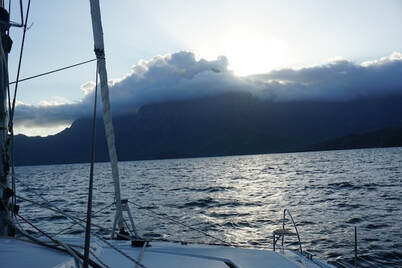 Hiva Oa, French Polynesia Hiva Oa, French Polynesia
Its mid-morning when we start to see land. The island of Hiva Oa is quite high and we are about 33nm out. The wind has been backing off and we are doing 3.8kts of boatspeed, and the expected arrival time is getting later and later. We decide to put the engines on for the last 33nm so we can arrive in daylight. As we get close to the anchorage we can see a large yacht moored outside the bay, where it is a bit rolly. Turns out to be our friends on VooDoo a 70’ Hylas which is just too big for the tight anchorage. We wait for Aranui V (well known, cargo / cruise ship) to come out before heading in. The anchorage in Atuona Bay is pretty tight but we find a space in the middle. A few boats around the fringes have set stern anchors set. We find SV Glam here as well which is lovely (especially as we can get onto their internet!) Voodoo drop by in the RIB to say hi, everyone is heading to another nearby anchorage tomorrow as we can’t check in until Tuesday, because it is Easter Saturday in this Catholic country. We send off a few emails and hit the hay fairly early. It’s nice to move back into our own side of the hull.
The 3,020 nm from Santa Cruz, Isabella took us 18.5 days (factoring I the time changes) and we averaged 6.7kts boat-speed. We have zero fresh fruit left and vegetable wise, half a cabbage and a potato, but plenty of meat, lentils and cans! The Parasailor was our only casualty and we can get that fixed in Hiva Oa. All in all it was a very easy and satisfying journey and importantly we are still speaking to each other! To read our daily log, check out our journey on noforeignland via the link below:
1 Comment
Joppy
13/6/2023 05:31:10 pm
Great, blog. What an amazing run. Don’t forget me for your last leg home 👍
Reply
Leave a Reply. |
AuthorAfter more than 5 years of (minus time off for Covid) and more than 27,000nm Lynda has finally got the hang of this cruising life Archives
June 2024
Categories |
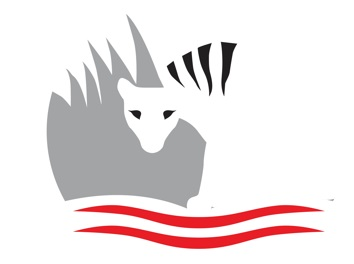
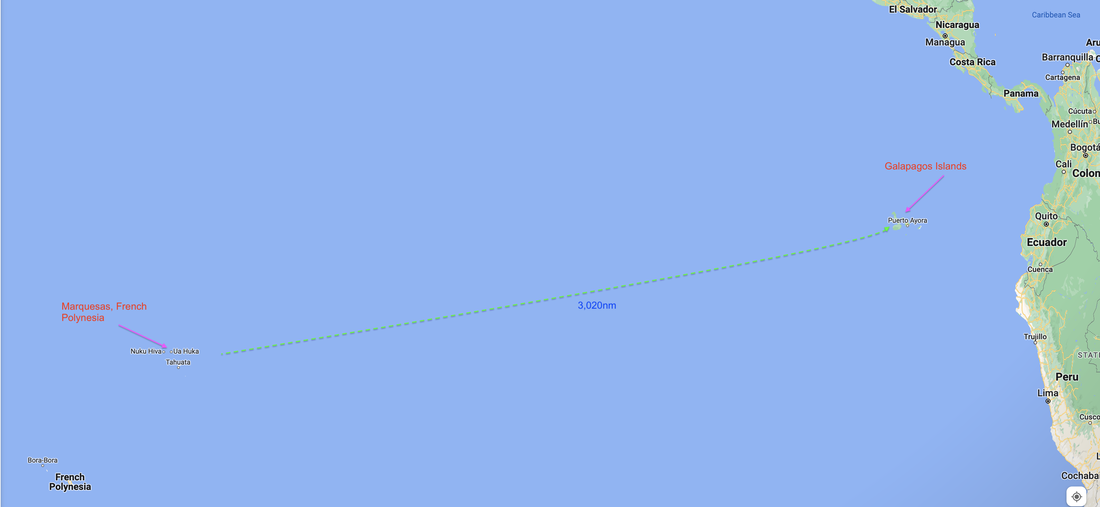
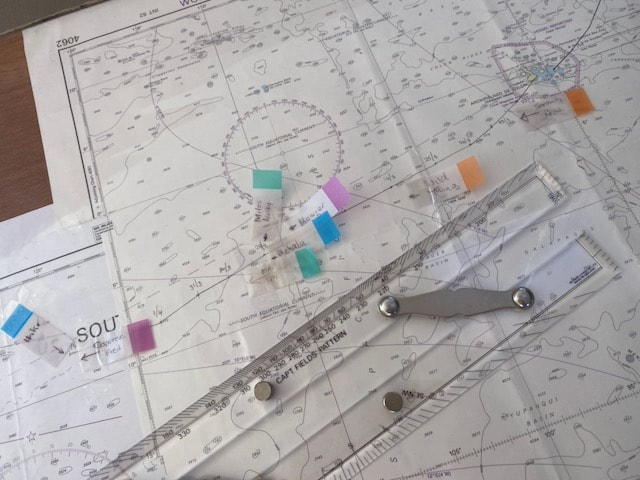

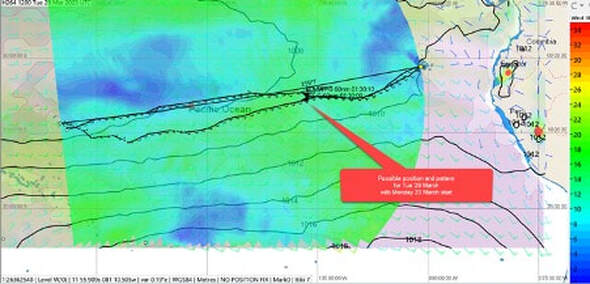
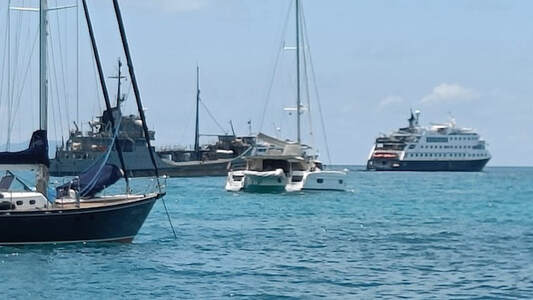
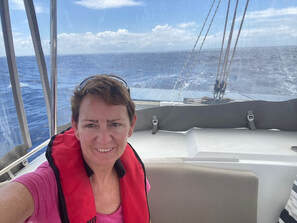
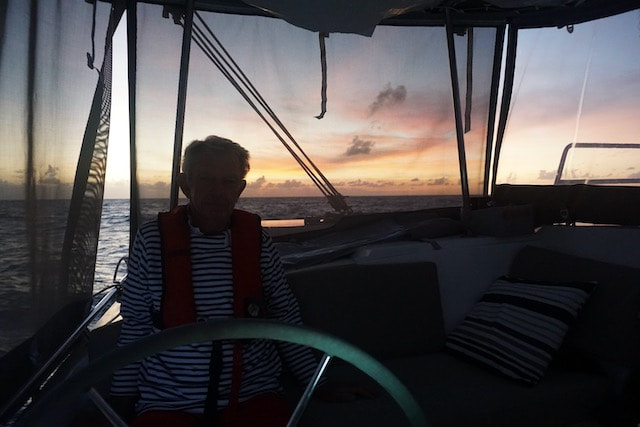
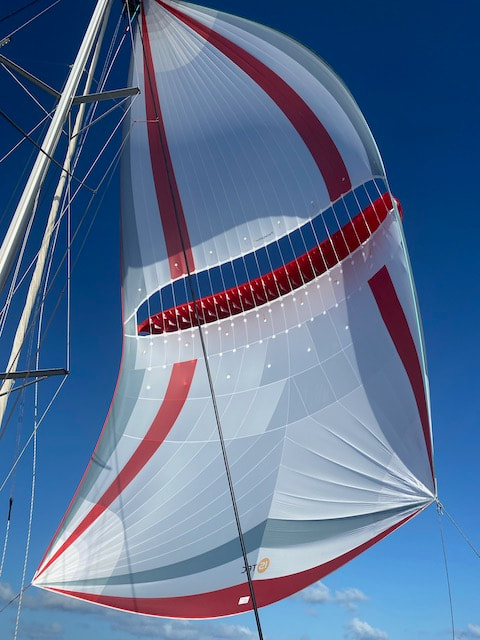
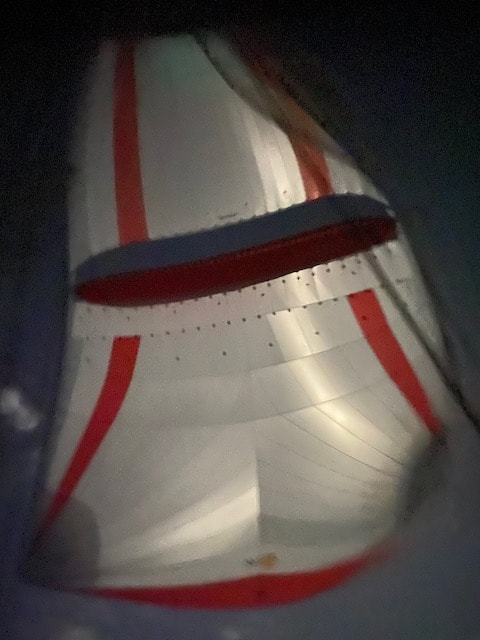
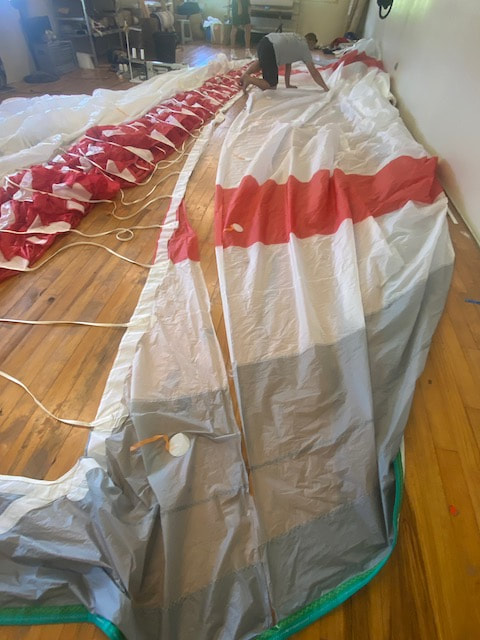
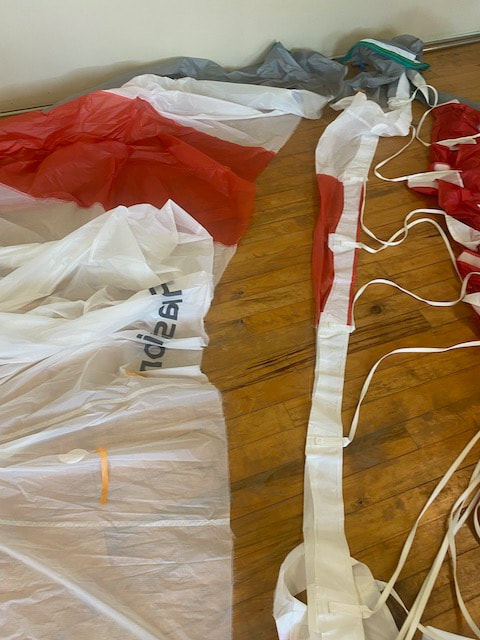
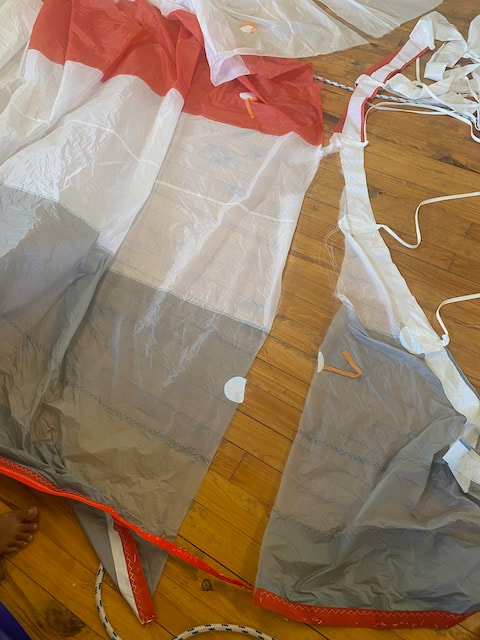
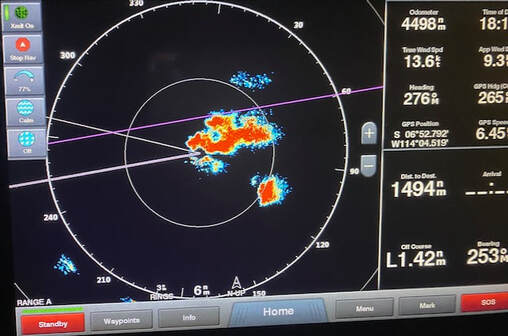
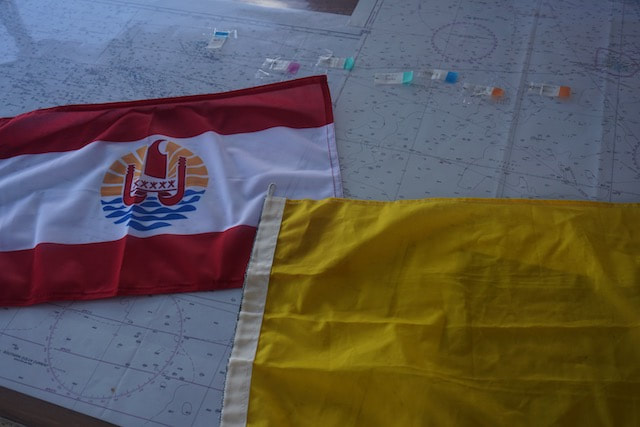

 RSS Feed
RSS Feed
